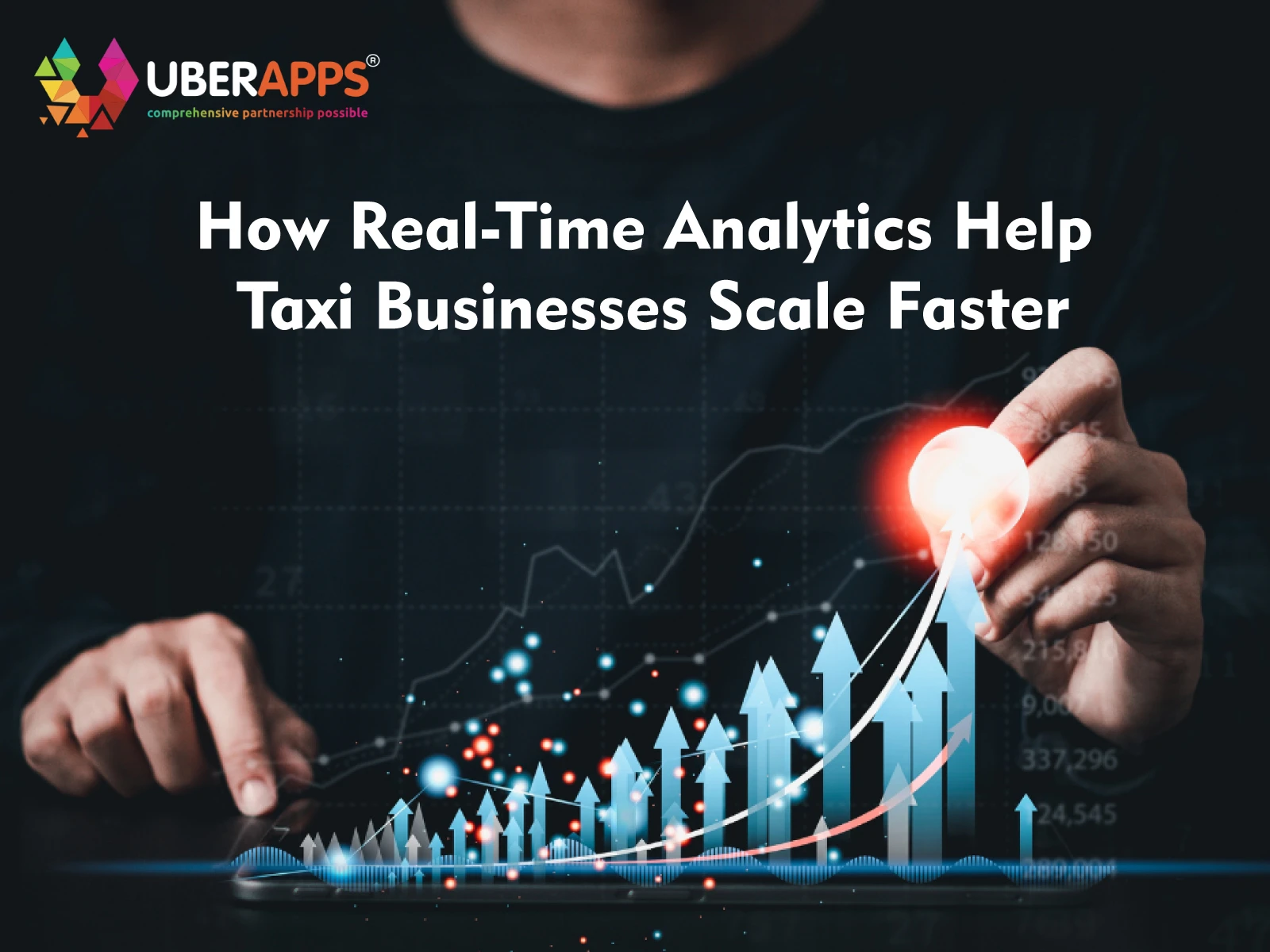
How Real-Time Analytics Help Taxi Businesses Scale Faster
Scaling a taxi business in today’s competitive ride-hailing market requires more than cars and drivers—it demands powerful data-driven decisions. Real-time analytics are now the backbone of smart taxi booking apps and Uber clone platforms. By delivering live insights into driver activity, passenger demand, payments, and operations, analytics dashboards empower both new startups and growing fleets to optimize routes, enhance customer service, and maximize revenue instantly.
Whether you’re building a taxi app from scratch or upgrading your solution, real-time data means your business can act, adapt, and outpace competitors in any city. Let’s explore how integrating analytics into your taxi app development strategy unlocks faster growth and smarter scaling for every operator.
Real-time analytics are transforming the taxi industry, giving operators the power to make instant decisions, personalize rider experiences, and optimize fleet operations. Modern taxi booking apps and SaaS platforms, like Uber Clone solutions, now feature dashboards that track driver performance, passenger demand, fare calculations, and payment flows, all in real time. By leveraging live data, taxi businesses can improve route optimization, reduce wait times, boost driver earnings, and enhance customer satisfaction. Predictive analytics further empower operators to position vehicles at high-demand locations, increase trip frequency, and provide more reliable service than competitors. As companies embrace advanced analytics features, administrative overhead drops, efficiency rises, and market expansion becomes seamless. Integrating real-time analytics into your taxi app development is the key to scaling your ride-hailing business faster and smarter.
Why Real-Time Analytics Matter in Taxi Booking Apps
Instantly Optimize Fleet Efficiency
- Track driver locations to reduce idle time and fuel costs
- Reassign vehicles to high-demand zones on the fly
- Cut average wait times and maximize completed rides
Key takeaway: Data-driven dispatching leads to better productivity and less wasted mileage.
Enhance Customer Satisfaction and Loyalty
Predict Demand and Placement
- Use predictive analytics to position cars ahead of surges
- Guarantee faster pickups and fewer cancellations
- Boost repeat rides through reliable service
Personalized Rider Experience
- Match riders to drivers based on preferences and proximity
- Deliver instant fare estimates and confirmation notifications
- Respond rapidly to customer feedback and improve retention.
Ride-Hailing App Features Empowered by Real-Time Data
Advanced Driver Performance Tracking
- Monitor acceptance and completion rates for every trip
- Quickly detect low-rated drivers and intervene proactively
- Reward top performers with on-the-spot incentives
Transparency and Fairness
- Use live data to resolve disputes over cancellations, pricing or trip routes instantly
- Maintain clear records with GPS route logs and message timestamps.
Smart Fare Calculation and Dynamic Pricing
Automated fare estimation based on distance, time, traffic, surge demand, and historical data
- Adjust prices instantly during peak or low-demand hours
- Keep rates transparent for both rider and driver
Key takeaway: No more fixed fares—dynamic pricing keeps earnings optimal and rides affordable.
Real-Time Payments and Financial Analytics
- Process in-app payments securely and seamlessly
- Monitor transaction errors, fraud, and payment status live
- Adapt to multi-currency and payment gateway requirements
In-app Payment Insights
- Use analytics to optimize wallet integrations and wallet usage
- Detect and prevent fraudulent bookings in real time.
The Power of Predictive Analytics in Taxi App Development
Smarter Demand Forecasting
- Predict peak times and underserved areas, then reposition vehicles proactively
- Avoid driver idle time and ensure more trips per shift
- Increase driver earnings and reduce turnover through better planning
Cost Savings and Competitive Advantage
Reduce administrative overhead by automating the decision process, saving up to 20% on operational costs
Build stronger market positioning with faster service than competitors
Data-Driven Growth Strategies
Expansion and Scalability
- Instantly assess city-by-city demand before entering new markets
- Scale fleets, set region-specific pricing, and manage resources efficiently
- Apply insights for strategic marketing campaigns, promotions or feature rollouts.
Business Intelligence for Taxi Operators
- Identify opportunity areas and emerging rider trends
- Refine app features and add-ons according to live performance data
- Achieve consistent service quality and operational excellence.
Steps to Implement Real-Time Analytics in Your Taxi Business
1 Choose a SaaS-Based Taxi App Platform
- Select apps with integrated analytics dashboards and scalable features
- Ensure they support in-app payments, live GPS tracking, and automated reporting
2 Integrate Smart Sensors and APIs
- Use phone sensors (GPS, accelerometer, gyroscope) for driver and route monitoring
- Connect to mapping APIs for real-time trip data
3 Set Up Admin Controls and Alerts
- Allow administrators to monitor performance and flag issues instantly
- Automate incentive schemes and dispute resolution systems
4 Train Teams for Data Interpretation
- Ensure drivers and support teams can use analytics for better service
- Implement feedback loops for continuous improvement
Real-World Success Stories Using Analytics
Uber Clone Solutions
- Predict surge pricing and demand spikes
- Customize promotions for various rider segments
- Deploy fleets strategically across diverse regions.
Regional Taxi Apps
- Use predictive analytics for rider-driver matching
- Minimize cancellations and maximize trip fulfillment
- Boost business efficiency, safety, and fraud avoidance.
Best Practices for Taxi Businesses Adopting Analytics
Start with High-Impact Metrics
- Ride requests, acceptance/completion rates
- Average wait and trip times
- Driver ratings and feedback
Automate Routine Tasks
- Use real-time rules to reassign drivers
- Change pricing and incentives
- Resolve common disputes
Regularly Optimize and Update Systems
- Learn from live performance dashboards
- Apply new policies as data trends change
- Scale tech to support more cities, currencies, and zones
Conclusion
In today’s ride-hailing landscape, real-time analytics are not a luxury they’re the ultimate competitive lever. Taxi booking apps powered by analytics give operators granular control over their business, help drivers earn more, and ensure riders receive fast, reliable service. Advanced dashboards let companies spot trends, address issues as they arise, and roll out new features in record time. By combining predictive demand planning, dynamic pricing, and live performance tracking, businesses cut costs, scale faster, and thrive in global markets.
Choosing robust analytics-integrated solutions like Uber Clone platforms or SaaS taxi apps means you can adapt to new cities, payment models, and customer needs with ease. As rider expectations grow, real-time data is the only way to meet them—making every trip smarter, safer, and more profitable for your taxi company.
FAQS
1. What metrics should taxi businesses track for growth?
Taxi businesses should track ride requests, driver acceptance and completion rates, customer ratings, and secure payments data to evaluate overall performance and operational efficiency.
2. How do real-time analytics improve driver earnings?
Real-time analytics position drivers in high-demand zones, enable dynamic pricing, minimize idle time, and boost completed trips—directly increasing driver earnings.
3. Can smaller taxi companies benefit from analytics?
Yes. SaaS-based ride-hailing software provides affordable yet powerful analytics dashboards that scale for startups, fleets, and enterprise taxi operators.
4. How do real-time analytics reduce customer wait times?
Advanced dispatch and predictive demand algorithms ensure drivers are positioned where demand spikes, significantly improving pickup time and rider experience.
5. What ride-hailing app features rely heavily on analytics?
Core features such as dynamic fare calculation, live GPS tracking, route optimization, and secure in-app payments depend on robust real-time analytics to perform effectively.
Author's Bio

Vinay Jain is the Founder of UBERApps and brings over 10 years of entrepreneurial experience. His focus revolves around software & business development and customer satisfaction.

